Innovation in Healthcare: Project Management and Quality Improvement
VerifiedAdded on 2023/06/18
|7
|2008
|370
Report
AI Summary
This report provides a summative assessment of quality improvement through healthcare innovation, focusing on the implementation of a wearable patch for sepsis prevention at University Hospital Wales. It analyzes the application of project management approaches, debating traditional vs. agile ...
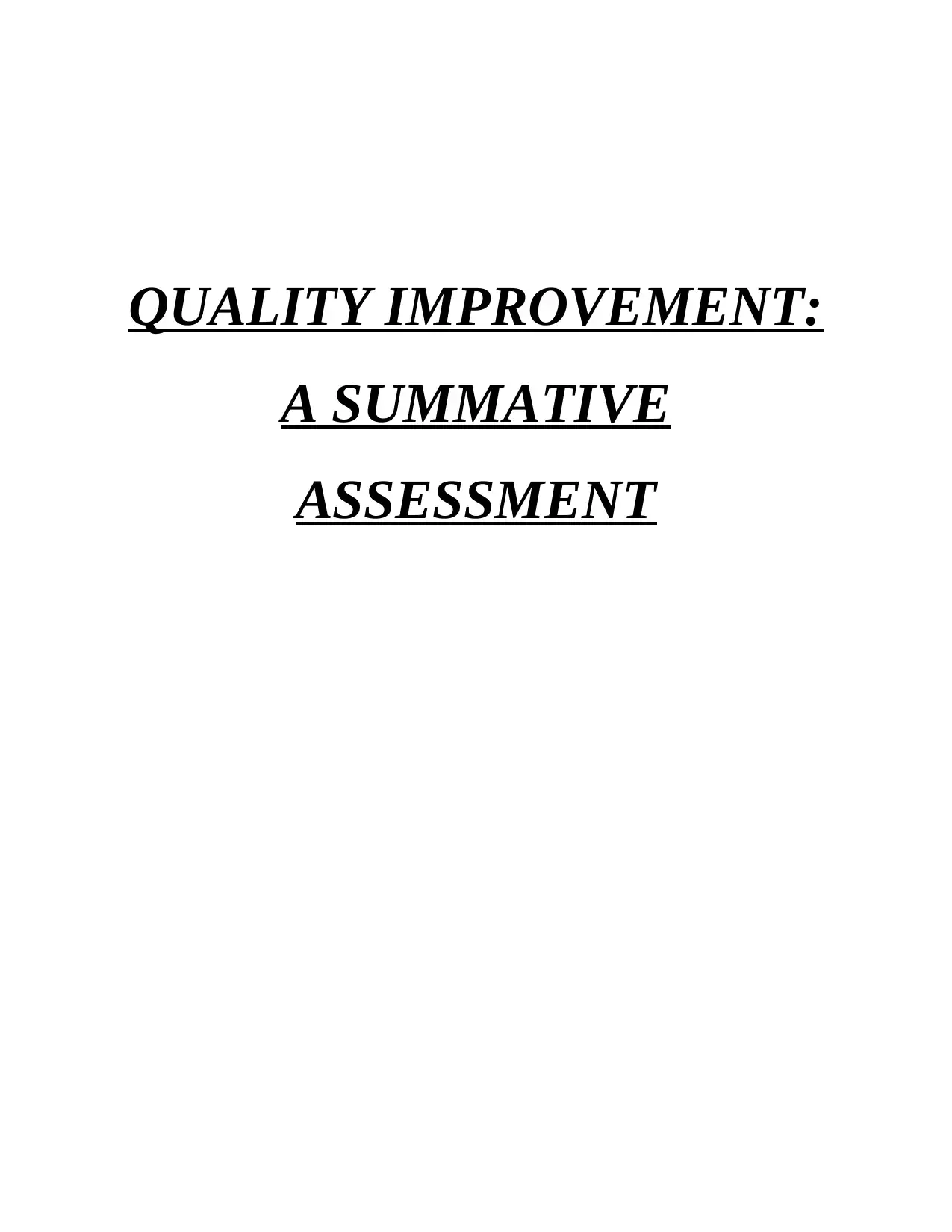
QUALITY IMPROVEMENT:
A SUMMATIVE
ASSESSMENT
A SUMMATIVE
ASSESSMENT
Paraphrase This Document
Need a fresh take? Get an instant paraphrase of this document with our AI Paraphraser
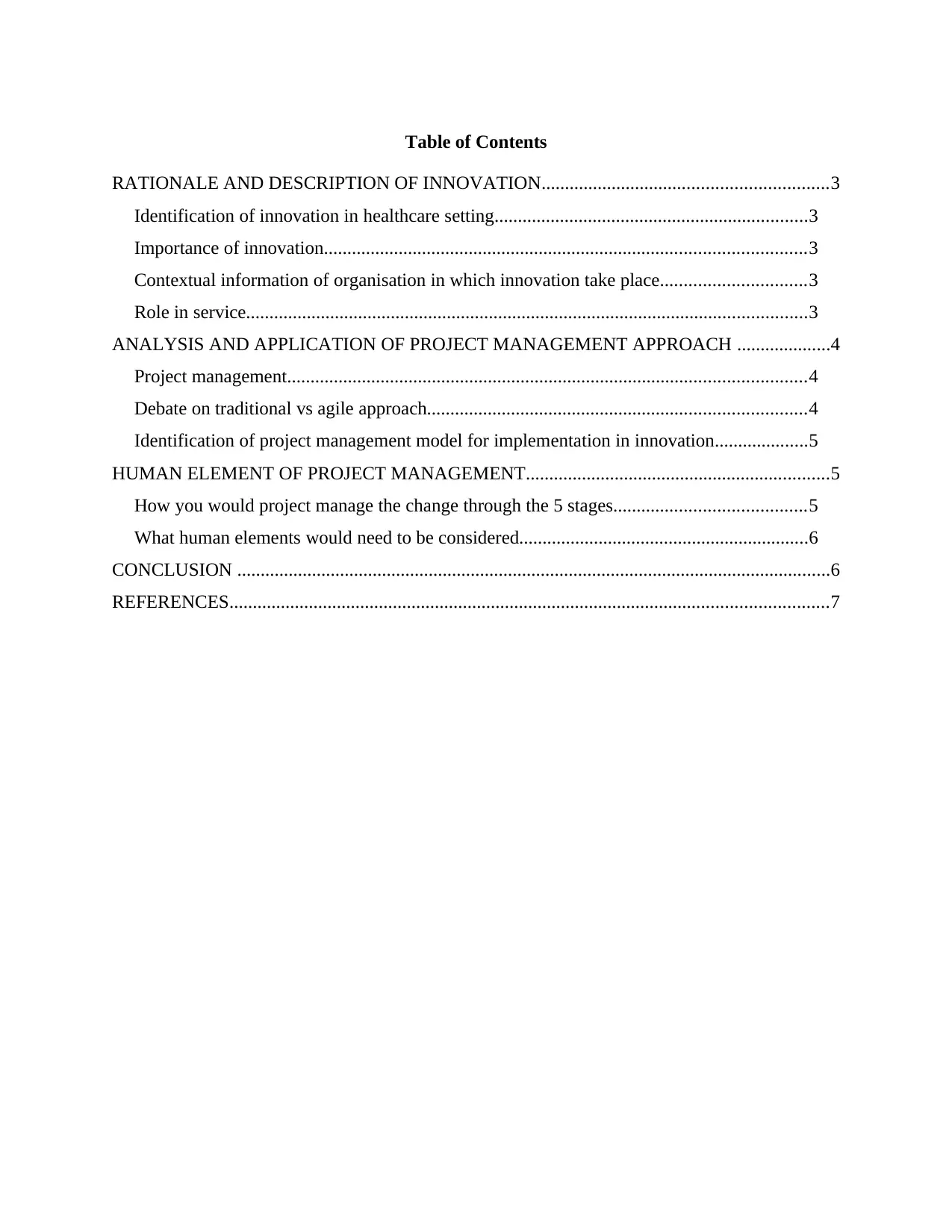
Table of Contents
RATIONALE AND DESCRIPTION OF INNOVATION.............................................................3
Identification of innovation in healthcare setting...................................................................3
Importance of innovation.......................................................................................................3
Contextual information of organisation in which innovation take place...............................3
Role in service........................................................................................................................3
ANALYSIS AND APPLICATION OF PROJECT MANAGEMENT APPROACH ....................4
Project management...............................................................................................................4
Debate on traditional vs agile approach.................................................................................4
Identification of project management model for implementation in innovation....................5
HUMAN ELEMENT OF PROJECT MANAGEMENT.................................................................5
How you would project manage the change through the 5 stages.........................................5
What human elements would need to be considered..............................................................6
CONCLUSION ...............................................................................................................................6
REFERENCES................................................................................................................................7
RATIONALE AND DESCRIPTION OF INNOVATION.............................................................3
Identification of innovation in healthcare setting...................................................................3
Importance of innovation.......................................................................................................3
Contextual information of organisation in which innovation take place...............................3
Role in service........................................................................................................................3
ANALYSIS AND APPLICATION OF PROJECT MANAGEMENT APPROACH ....................4
Project management...............................................................................................................4
Debate on traditional vs agile approach.................................................................................4
Identification of project management model for implementation in innovation....................5
HUMAN ELEMENT OF PROJECT MANAGEMENT.................................................................5
How you would project manage the change through the 5 stages.........................................5
What human elements would need to be considered..............................................................6
CONCLUSION ...............................................................................................................................6
REFERENCES................................................................................................................................7
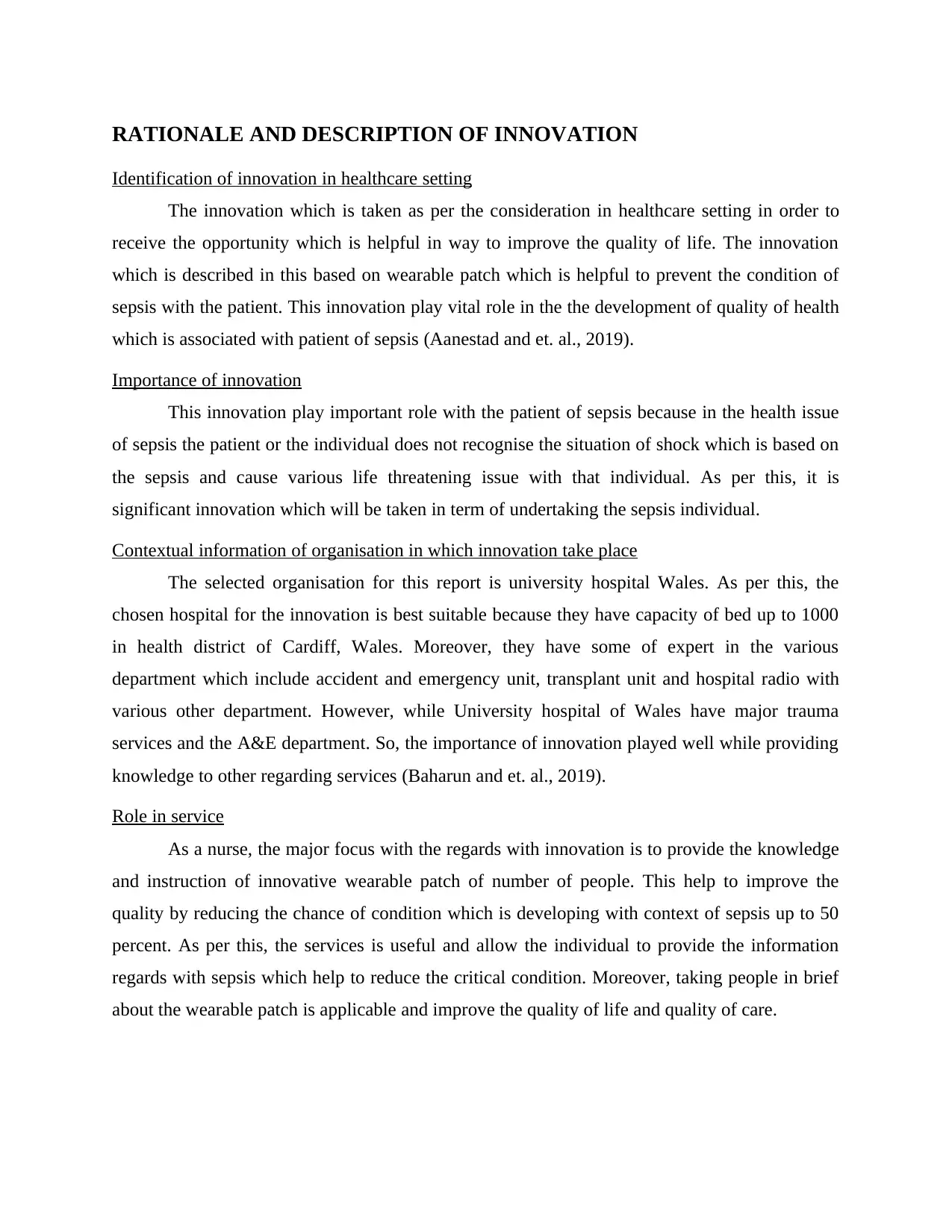
RATIONALE AND DESCRIPTION OF INNOVATION
Identification of innovation in healthcare setting
The innovation which is taken as per the consideration in healthcare setting in order to
receive the opportunity which is helpful in way to improve the quality of life. The innovation
which is described in this based on wearable patch which is helpful to prevent the condition of
sepsis with the patient. This innovation play vital role in the the development of quality of health
which is associated with patient of sepsis (Aanestad and et. al., 2019).
Importance of innovation
This innovation play important role with the patient of sepsis because in the health issue
of sepsis the patient or the individual does not recognise the situation of shock which is based on
the sepsis and cause various life threatening issue with that individual. As per this, it is
significant innovation which will be taken in term of undertaking the sepsis individual.
Contextual information of organisation in which innovation take place
The selected organisation for this report is university hospital Wales. As per this, the
chosen hospital for the innovation is best suitable because they have capacity of bed up to 1000
in health district of Cardiff, Wales. Moreover, they have some of expert in the various
department which include accident and emergency unit, transplant unit and hospital radio with
various other department. However, while University hospital of Wales have major trauma
services and the A&E department. So, the importance of innovation played well while providing
knowledge to other regarding services (Baharun and et. al., 2019).
Role in service
As a nurse, the major focus with the regards with innovation is to provide the knowledge
and instruction of innovative wearable patch of number of people. This help to improve the
quality by reducing the chance of condition which is developing with context of sepsis up to 50
percent. As per this, the services is useful and allow the individual to provide the information
regards with sepsis which help to reduce the critical condition. Moreover, taking people in brief
about the wearable patch is applicable and improve the quality of life and quality of care.
Identification of innovation in healthcare setting
The innovation which is taken as per the consideration in healthcare setting in order to
receive the opportunity which is helpful in way to improve the quality of life. The innovation
which is described in this based on wearable patch which is helpful to prevent the condition of
sepsis with the patient. This innovation play vital role in the the development of quality of health
which is associated with patient of sepsis (Aanestad and et. al., 2019).
Importance of innovation
This innovation play important role with the patient of sepsis because in the health issue
of sepsis the patient or the individual does not recognise the situation of shock which is based on
the sepsis and cause various life threatening issue with that individual. As per this, it is
significant innovation which will be taken in term of undertaking the sepsis individual.
Contextual information of organisation in which innovation take place
The selected organisation for this report is university hospital Wales. As per this, the
chosen hospital for the innovation is best suitable because they have capacity of bed up to 1000
in health district of Cardiff, Wales. Moreover, they have some of expert in the various
department which include accident and emergency unit, transplant unit and hospital radio with
various other department. However, while University hospital of Wales have major trauma
services and the A&E department. So, the importance of innovation played well while providing
knowledge to other regarding services (Baharun and et. al., 2019).
Role in service
As a nurse, the major focus with the regards with innovation is to provide the knowledge
and instruction of innovative wearable patch of number of people. This help to improve the
quality by reducing the chance of condition which is developing with context of sepsis up to 50
percent. As per this, the services is useful and allow the individual to provide the information
regards with sepsis which help to reduce the critical condition. Moreover, taking people in brief
about the wearable patch is applicable and improve the quality of life and quality of care.
⊘ This is a preview!⊘
Do you want full access?
Subscribe today to unlock all pages.

Trusted by 1+ million students worldwide
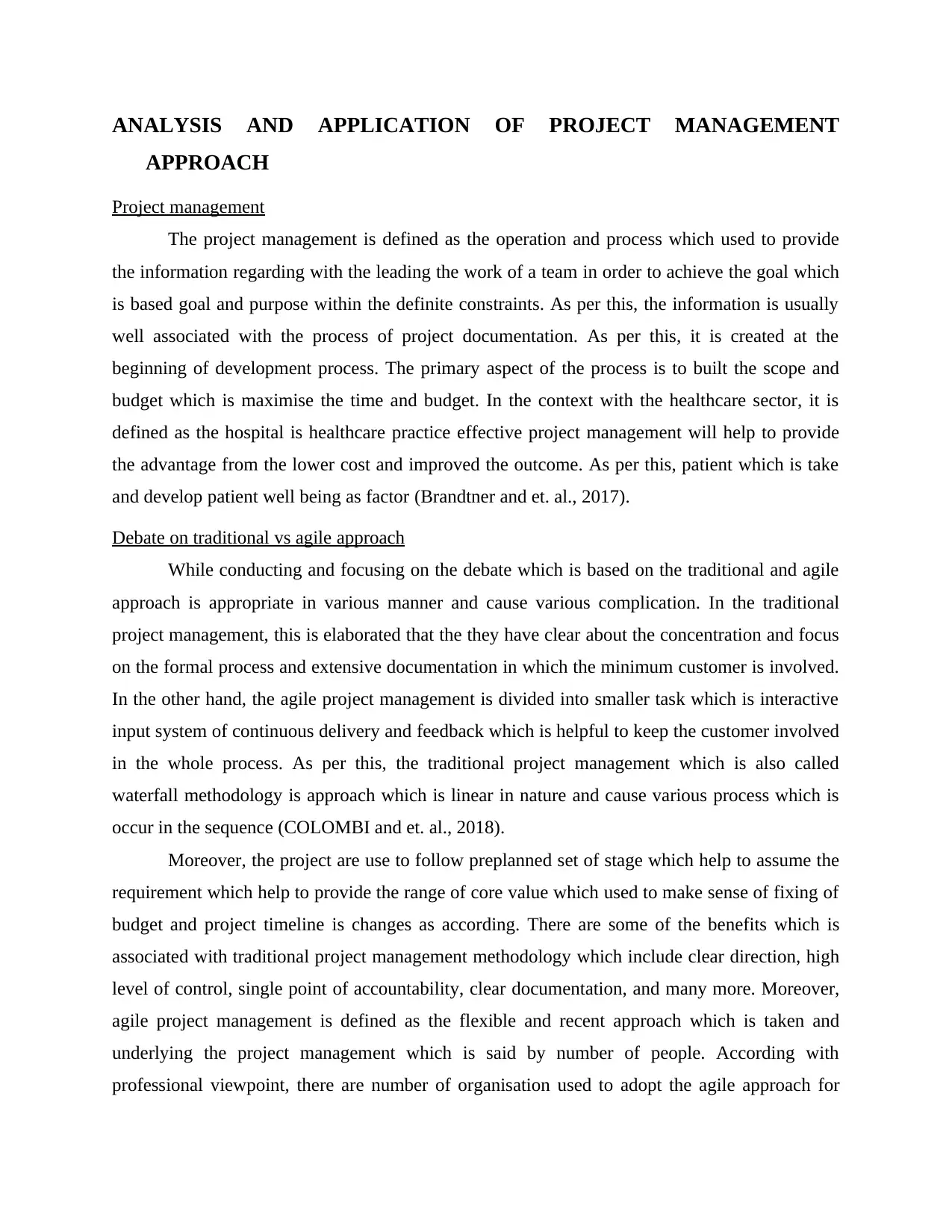
ANALYSIS AND APPLICATION OF PROJECT MANAGEMENT
APPROACH
Project management
The project management is defined as the operation and process which used to provide
the information regarding with the leading the work of a team in order to achieve the goal which
is based goal and purpose within the definite constraints. As per this, the information is usually
well associated with the process of project documentation. As per this, it is created at the
beginning of development process. The primary aspect of the process is to built the scope and
budget which is maximise the time and budget. In the context with the healthcare sector, it is
defined as the hospital is healthcare practice effective project management will help to provide
the advantage from the lower cost and improved the outcome. As per this, patient which is take
and develop patient well being as factor (Brandtner and et. al., 2017).
Debate on traditional vs agile approach
While conducting and focusing on the debate which is based on the traditional and agile
approach is appropriate in various manner and cause various complication. In the traditional
project management, this is elaborated that the they have clear about the concentration and focus
on the formal process and extensive documentation in which the minimum customer is involved.
In the other hand, the agile project management is divided into smaller task which is interactive
input system of continuous delivery and feedback which is helpful to keep the customer involved
in the whole process. As per this, the traditional project management which is also called
waterfall methodology is approach which is linear in nature and cause various process which is
occur in the sequence (COLOMBI and et. al., 2018).
Moreover, the project are use to follow preplanned set of stage which help to assume the
requirement which help to provide the range of core value which used to make sense of fixing of
budget and project timeline is changes as according. There are some of the benefits which is
associated with traditional project management methodology which include clear direction, high
level of control, single point of accountability, clear documentation, and many more. Moreover,
agile project management is defined as the flexible and recent approach which is taken and
underlying the project management which is said by number of people. According with
professional viewpoint, there are number of organisation used to adopt the agile approach for
APPROACH
Project management
The project management is defined as the operation and process which used to provide
the information regarding with the leading the work of a team in order to achieve the goal which
is based goal and purpose within the definite constraints. As per this, the information is usually
well associated with the process of project documentation. As per this, it is created at the
beginning of development process. The primary aspect of the process is to built the scope and
budget which is maximise the time and budget. In the context with the healthcare sector, it is
defined as the hospital is healthcare practice effective project management will help to provide
the advantage from the lower cost and improved the outcome. As per this, patient which is take
and develop patient well being as factor (Brandtner and et. al., 2017).
Debate on traditional vs agile approach
While conducting and focusing on the debate which is based on the traditional and agile
approach is appropriate in various manner and cause various complication. In the traditional
project management, this is elaborated that the they have clear about the concentration and focus
on the formal process and extensive documentation in which the minimum customer is involved.
In the other hand, the agile project management is divided into smaller task which is interactive
input system of continuous delivery and feedback which is helpful to keep the customer involved
in the whole process. As per this, the traditional project management which is also called
waterfall methodology is approach which is linear in nature and cause various process which is
occur in the sequence (COLOMBI and et. al., 2018).
Moreover, the project are use to follow preplanned set of stage which help to assume the
requirement which help to provide the range of core value which used to make sense of fixing of
budget and project timeline is changes as according. There are some of the benefits which is
associated with traditional project management methodology which include clear direction, high
level of control, single point of accountability, clear documentation, and many more. Moreover,
agile project management is defined as the flexible and recent approach which is taken and
underlying the project management which is said by number of people. According with
professional viewpoint, there are number of organisation used to adopt the agile approach for
Paraphrase This Document
Need a fresh take? Get an instant paraphrase of this document with our AI Paraphraser
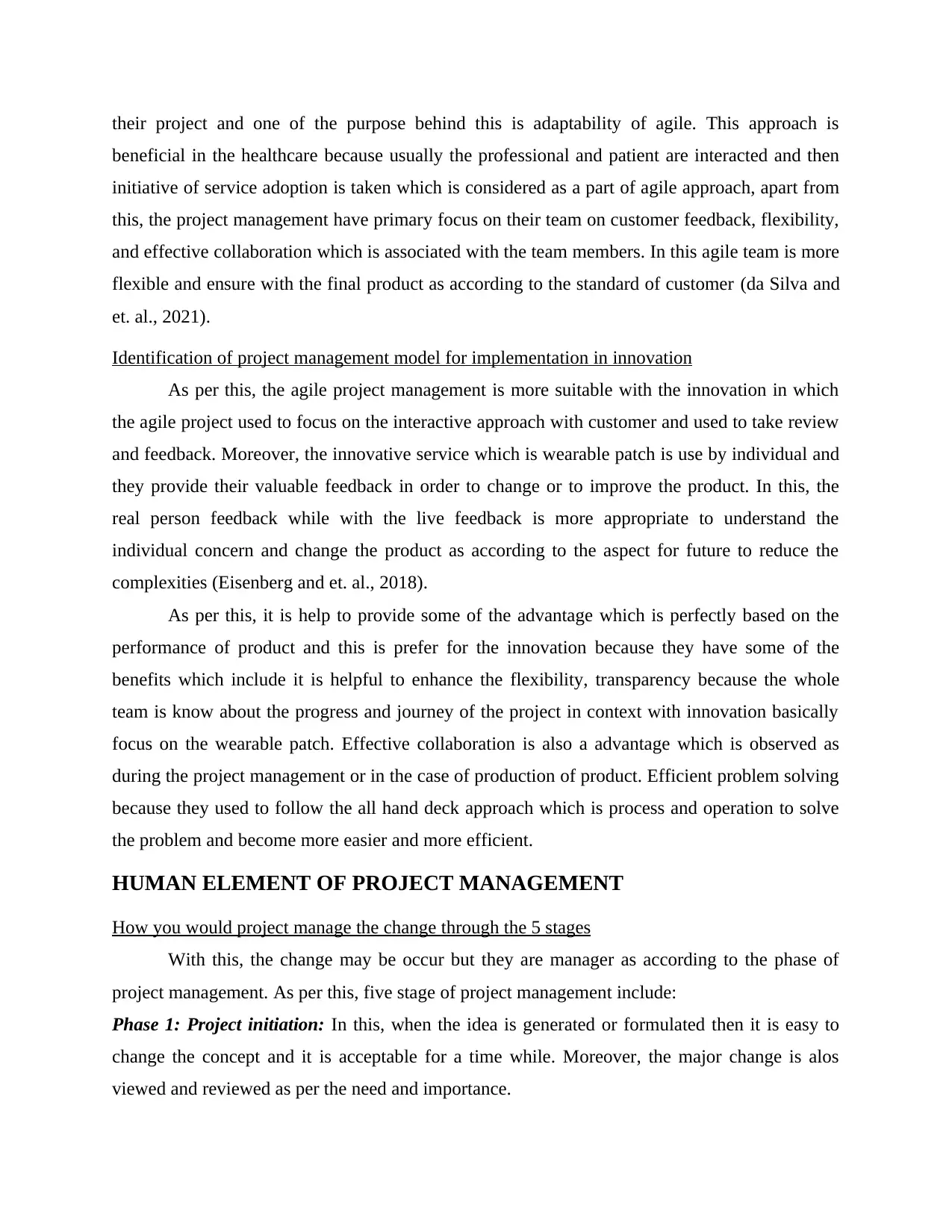
their project and one of the purpose behind this is adaptability of agile. This approach is
beneficial in the healthcare because usually the professional and patient are interacted and then
initiative of service adoption is taken which is considered as a part of agile approach, apart from
this, the project management have primary focus on their team on customer feedback, flexibility,
and effective collaboration which is associated with the team members. In this agile team is more
flexible and ensure with the final product as according to the standard of customer (da Silva and
et. al., 2021).
Identification of project management model for implementation in innovation
As per this, the agile project management is more suitable with the innovation in which
the agile project used to focus on the interactive approach with customer and used to take review
and feedback. Moreover, the innovative service which is wearable patch is use by individual and
they provide their valuable feedback in order to change or to improve the product. In this, the
real person feedback while with the live feedback is more appropriate to understand the
individual concern and change the product as according to the aspect for future to reduce the
complexities (Eisenberg and et. al., 2018).
As per this, it is help to provide some of the advantage which is perfectly based on the
performance of product and this is prefer for the innovation because they have some of the
benefits which include it is helpful to enhance the flexibility, transparency because the whole
team is know about the progress and journey of the project in context with innovation basically
focus on the wearable patch. Effective collaboration is also a advantage which is observed as
during the project management or in the case of production of product. Efficient problem solving
because they used to follow the all hand deck approach which is process and operation to solve
the problem and become more easier and more efficient.
HUMAN ELEMENT OF PROJECT MANAGEMENT
How you would project manage the change through the 5 stages
With this, the change may be occur but they are manager as according to the phase of
project management. As per this, five stage of project management include:
Phase 1: Project initiation: In this, when the idea is generated or formulated then it is easy to
change the concept and it is acceptable for a time while. Moreover, the major change is alos
viewed and reviewed as per the need and importance.
beneficial in the healthcare because usually the professional and patient are interacted and then
initiative of service adoption is taken which is considered as a part of agile approach, apart from
this, the project management have primary focus on their team on customer feedback, flexibility,
and effective collaboration which is associated with the team members. In this agile team is more
flexible and ensure with the final product as according to the standard of customer (da Silva and
et. al., 2021).
Identification of project management model for implementation in innovation
As per this, the agile project management is more suitable with the innovation in which
the agile project used to focus on the interactive approach with customer and used to take review
and feedback. Moreover, the innovative service which is wearable patch is use by individual and
they provide their valuable feedback in order to change or to improve the product. In this, the
real person feedback while with the live feedback is more appropriate to understand the
individual concern and change the product as according to the aspect for future to reduce the
complexities (Eisenberg and et. al., 2018).
As per this, it is help to provide some of the advantage which is perfectly based on the
performance of product and this is prefer for the innovation because they have some of the
benefits which include it is helpful to enhance the flexibility, transparency because the whole
team is know about the progress and journey of the project in context with innovation basically
focus on the wearable patch. Effective collaboration is also a advantage which is observed as
during the project management or in the case of production of product. Efficient problem solving
because they used to follow the all hand deck approach which is process and operation to solve
the problem and become more easier and more efficient.
HUMAN ELEMENT OF PROJECT MANAGEMENT
How you would project manage the change through the 5 stages
With this, the change may be occur but they are manager as according to the phase of
project management. As per this, five stage of project management include:
Phase 1: Project initiation: In this, when the idea is generated or formulated then it is easy to
change the concept and it is acceptable for a time while. Moreover, the major change is alos
viewed and reviewed as per the need and importance.
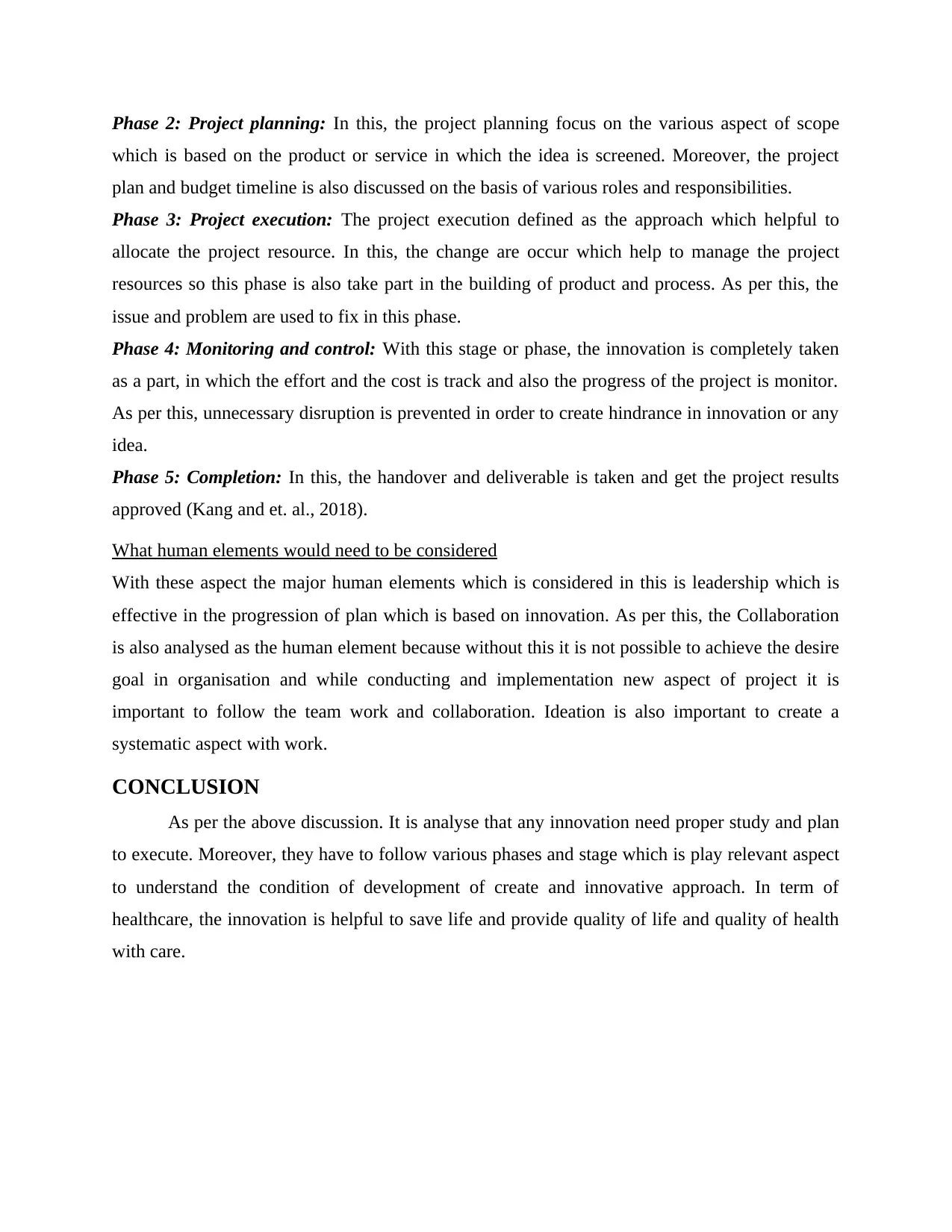
Phase 2: Project planning: In this, the project planning focus on the various aspect of scope
which is based on the product or service in which the idea is screened. Moreover, the project
plan and budget timeline is also discussed on the basis of various roles and responsibilities.
Phase 3: Project execution: The project execution defined as the approach which helpful to
allocate the project resource. In this, the change are occur which help to manage the project
resources so this phase is also take part in the building of product and process. As per this, the
issue and problem are used to fix in this phase.
Phase 4: Monitoring and control: With this stage or phase, the innovation is completely taken
as a part, in which the effort and the cost is track and also the progress of the project is monitor.
As per this, unnecessary disruption is prevented in order to create hindrance in innovation or any
idea.
Phase 5: Completion: In this, the handover and deliverable is taken and get the project results
approved (Kang and et. al., 2018).
What human elements would need to be considered
With these aspect the major human elements which is considered in this is leadership which is
effective in the progression of plan which is based on innovation. As per this, the Collaboration
is also analysed as the human element because without this it is not possible to achieve the desire
goal in organisation and while conducting and implementation new aspect of project it is
important to follow the team work and collaboration. Ideation is also important to create a
systematic aspect with work.
CONCLUSION
As per the above discussion. It is analyse that any innovation need proper study and plan
to execute. Moreover, they have to follow various phases and stage which is play relevant aspect
to understand the condition of development of create and innovative approach. In term of
healthcare, the innovation is helpful to save life and provide quality of life and quality of health
with care.
which is based on the product or service in which the idea is screened. Moreover, the project
plan and budget timeline is also discussed on the basis of various roles and responsibilities.
Phase 3: Project execution: The project execution defined as the approach which helpful to
allocate the project resource. In this, the change are occur which help to manage the project
resources so this phase is also take part in the building of product and process. As per this, the
issue and problem are used to fix in this phase.
Phase 4: Monitoring and control: With this stage or phase, the innovation is completely taken
as a part, in which the effort and the cost is track and also the progress of the project is monitor.
As per this, unnecessary disruption is prevented in order to create hindrance in innovation or any
idea.
Phase 5: Completion: In this, the handover and deliverable is taken and get the project results
approved (Kang and et. al., 2018).
What human elements would need to be considered
With these aspect the major human elements which is considered in this is leadership which is
effective in the progression of plan which is based on innovation. As per this, the Collaboration
is also analysed as the human element because without this it is not possible to achieve the desire
goal in organisation and while conducting and implementation new aspect of project it is
important to follow the team work and collaboration. Ideation is also important to create a
systematic aspect with work.
CONCLUSION
As per the above discussion. It is analyse that any innovation need proper study and plan
to execute. Moreover, they have to follow various phases and stage which is play relevant aspect
to understand the condition of development of create and innovative approach. In term of
healthcare, the innovation is helpful to save life and provide quality of life and quality of health
with care.
⊘ This is a preview!⊘
Do you want full access?
Subscribe today to unlock all pages.

Trusted by 1+ million students worldwide
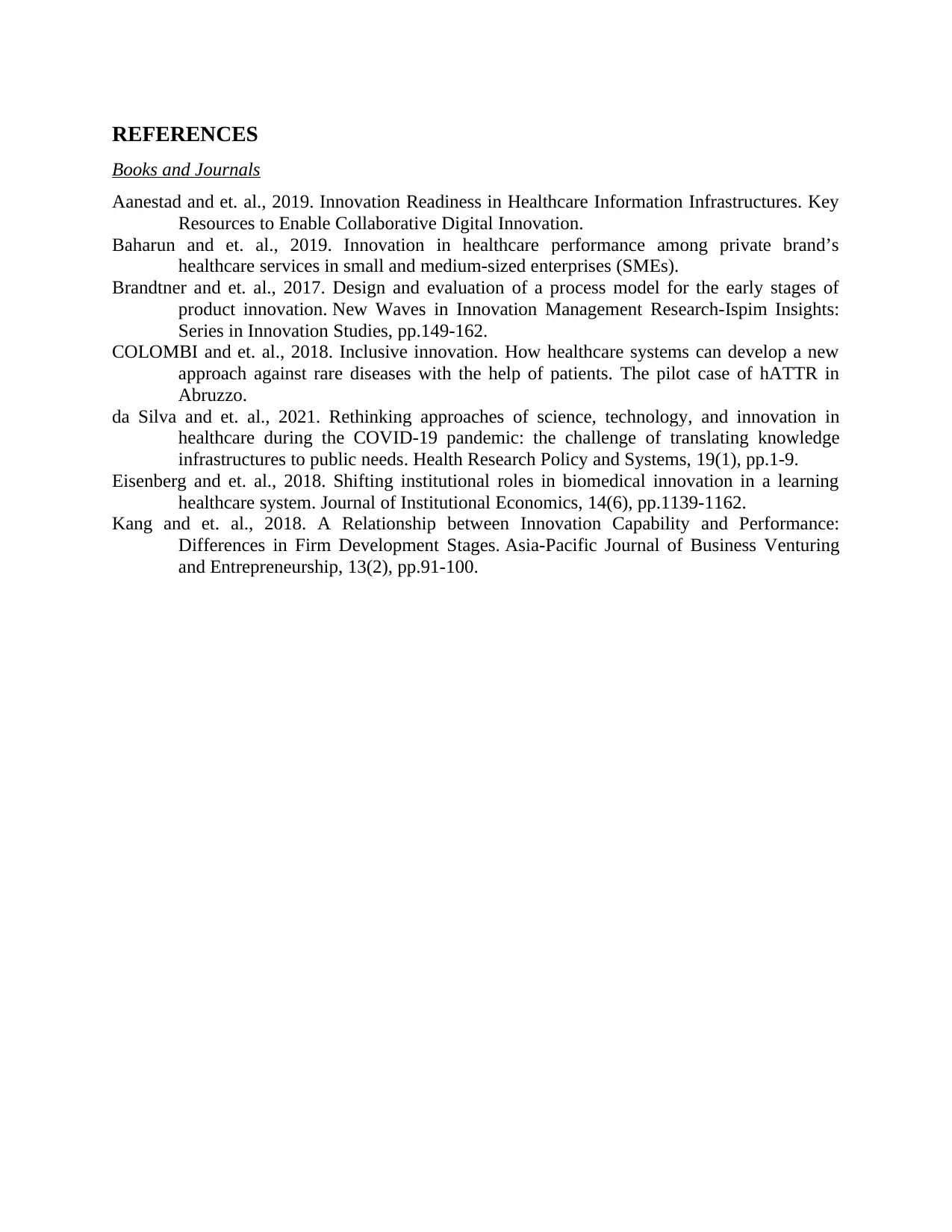
REFERENCES
Books and Journals
Aanestad and et. al., 2019. Innovation Readiness in Healthcare Information Infrastructures. Key
Resources to Enable Collaborative Digital Innovation.
Baharun and et. al., 2019. Innovation in healthcare performance among private brand’s
healthcare services in small and medium-sized enterprises (SMEs).
Brandtner and et. al., 2017. Design and evaluation of a process model for the early stages of
product innovation. New Waves in Innovation Management Research-Ispim Insights:
Series in Innovation Studies, pp.149-162.
COLOMBI and et. al., 2018. Inclusive innovation. How healthcare systems can develop a new
approach against rare diseases with the help of patients. The pilot case of hATTR in
Abruzzo.
da Silva and et. al., 2021. Rethinking approaches of science, technology, and innovation in
healthcare during the COVID-19 pandemic: the challenge of translating knowledge
infrastructures to public needs. Health Research Policy and Systems, 19(1), pp.1-9.
Eisenberg and et. al., 2018. Shifting institutional roles in biomedical innovation in a learning
healthcare system. Journal of Institutional Economics, 14(6), pp.1139-1162.
Kang and et. al., 2018. A Relationship between Innovation Capability and Performance:
Differences in Firm Development Stages. Asia-Pacific Journal of Business Venturing
and Entrepreneurship, 13(2), pp.91-100.
Books and Journals
Aanestad and et. al., 2019. Innovation Readiness in Healthcare Information Infrastructures. Key
Resources to Enable Collaborative Digital Innovation.
Baharun and et. al., 2019. Innovation in healthcare performance among private brand’s
healthcare services in small and medium-sized enterprises (SMEs).
Brandtner and et. al., 2017. Design and evaluation of a process model for the early stages of
product innovation. New Waves in Innovation Management Research-Ispim Insights:
Series in Innovation Studies, pp.149-162.
COLOMBI and et. al., 2018. Inclusive innovation. How healthcare systems can develop a new
approach against rare diseases with the help of patients. The pilot case of hATTR in
Abruzzo.
da Silva and et. al., 2021. Rethinking approaches of science, technology, and innovation in
healthcare during the COVID-19 pandemic: the challenge of translating knowledge
infrastructures to public needs. Health Research Policy and Systems, 19(1), pp.1-9.
Eisenberg and et. al., 2018. Shifting institutional roles in biomedical innovation in a learning
healthcare system. Journal of Institutional Economics, 14(6), pp.1139-1162.
Kang and et. al., 2018. A Relationship between Innovation Capability and Performance:
Differences in Firm Development Stages. Asia-Pacific Journal of Business Venturing
and Entrepreneurship, 13(2), pp.91-100.
1 out of 7
Related Documents
Your All-in-One AI-Powered Toolkit for Academic Success.
+13062052269
info@desklib.com
Available 24*7 on WhatsApp / Email
![[object Object]](/_next/static/media/star-bottom.7253800d.svg)
Unlock your academic potential
© 2024 | Zucol Services PVT LTD | All rights reserved.




